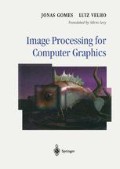Abstract
We have seen that the mathematical model appropriate for the representation of spectral color space is a finite-dimensional vector space. A representation space is associated with every physical color system, be it a receptor or an emitter. A receptor samples the spectral distribution function of the incident light, while an emitter performs color reconstruction by combining the elements of its basis of primary colors, which generate the emitter’s color space.
Access this chapter
Tax calculation will be finalised at checkout
Purchases are for personal use only
Preview
Unable to display preview. Download preview PDF.
References
Foley, J. D., van Dam, A., Feiner, S. K, and Hughes, J. E (1990). Fundamentals of Interactive Computer Graphics, second ed. Addison-Wesley, Reading, MA.
Hall, R. A. (1989). Illumination and Color in Computer Generated Imagery. Springer-Verlag, New York.
Hall, R. A. and Greenberg, D. P. (1983). A testbed for realistic image synthesis IEEE Computer Graphics and Applications, 3: 10–20.
Joblove, G. H. and Greenberg, D. (1978). Color spaces for computer graphics. Computer Graphics (SIGGRAPH ‘78 Proceedings), 12 (3): 20–25.
Meyer, G. W. (1988). Wavelength selection for synthetic image generation. Computer Vision, Graphics and Image Processing, 41: 57–79.
Michener, J. C. and Van Dam, A. (1978). A functional overview of the Core System with glossary. ACM Computing Surveys, 10: 381–387.
Padgham, C. A. and Saunders, J. E. (1975). The Perception of Light and Color. Academic Press, New York.
Rogers, D. E (1985). Procedural Elements for Computer Graphics. McGraw-Hill, New York.
Smith, A. R. (1978). Color gamut transform pairs. Computer Graphics (SIGGRAPH ‘78 Proceedings), 12 (3): 12–19.
Smith, A. R. (1981). Color tutorial notes. Technical Report No. 37, Lucasfilm.
Wyszecki, G. and Stiles, W. S. (1982). Color Science. John Wiley & Sons, New York.
Author information
Authors and Affiliations
Rights and permissions
Copyright information
© 1997 Springer Science+Business Media New York
About this chapter
Cite this chapter
Gomes, J., Velho, L. (1997). Color Systems. In: Image Processing for Computer Graphics. Springer, New York, NY. https://doi.org/10.1007/978-1-4757-2745-6_4
Download citation
DOI: https://doi.org/10.1007/978-1-4757-2745-6_4
Publisher Name: Springer, New York, NY
Print ISBN: 978-1-4757-2747-0
Online ISBN: 978-1-4757-2745-6
eBook Packages: Springer Book Archive

